Squint, and you’ll see a lot of F-150 in Ford’s new 2024 Ranger. You might think that of the outgoing Ranger, but that softer-shouldered rig looks more like a distant cousin than a brother to the bigger truck. That’s because the last Ranger was really a hedge by Ford when they needed to fill in a truck in the mid-size space and borrowed from what sells in the rest of the world. How come? Everywhere else on Earth, save the U.S. and Canada, Ford’s best-selling truck isn’t an F-150, it’s a Ranger. That’s saying something, since the F-150 is an icon in the U.S., and isn’t just the best-selling pickup, but usually the best-selling vehicle on American roads.
So it’s understandable that when Ford last updated the Ranger in 2019 (after killing it off in 2012 in the U.S.) they were just jamming fingers into the leaky sales dyke by cutting and pasting in bits from what sells on the rest of the planet.
Now, though, the mid-sized truck segment is hot, and Ford wants to take advantage, especially since the leader in the U.S. mid-sized pickups isn’t Ford: It’s Toyota’s Tacoma, a truck that’s likely about to see an overhaul of its own.
Ford wasn’t about to stand still waiting for Toyota to up its game; it's made huge changes to the 2024 Ranger (we’ll just hit the highlight reel). There’s also a bunch we don’t yet know about. We haven’t driven the new Ranger quite yet, either, but we sure look forward to that! Meanwhile, here’s the lowdown on the new Ranger—and the first-ever Ranger Raptor.
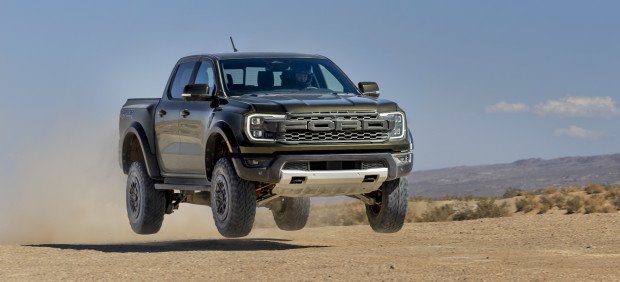
Courtesy Image
2024 Ford Ranger and Raptor Specs
Horsepower
Ford went through thorough focus-grouping of the current Ranger to find out the likes and dislikes. Number one on the list of “meh” was that buyers wanted more giddy-up. So Ford tapped the 2.7-liter turbo that’s available on the Ford Bronco for the 2024 Ranger, and it’s going to make a large difference. It’ll bounce out 315hp, which edges the Nissan Frontier’s 310hp, and wallops that truck’s maximum 281 lb. ft. of torque with 400 lb. ft. We’ll hedge here and say that torque is felt more than horsepower, especially in a truck and especially at lower RPM, so we’ll give Ford’s edge an asterisk until we test-drive the 2024 Ranger, but on paper that’s a very big bump.
If you’re in the market for a base Ranger, that truck will retain the 2023 model’s 2.3-liter EcoBoost with 270hp and 310 lb. ft. of torque, and all Rangers get a 10-speed automatic.
The 2024 Ford Raptor? It’s getting a 3.0-liter turbocharged V-6 with 405hp and 430 lb. ft. of torque, so those worries about middling power will certainly be put to rest there.
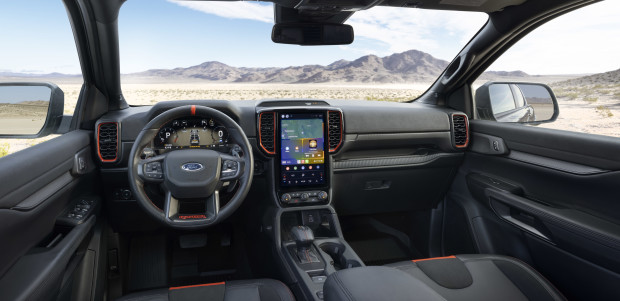
Courtesy Image
Tech and Comfort
There’s a funny facet of the mid-size truck segment: It’s almost like carmakers forget people drive them to work. For way too long they’ve gotten short shrift on interiors. Ford, too, has been guilty here, but the 2024 Ranger addresses that big time.
Ford’s adding a 10.1-inch touchscreen, standard, with a larger 12-incher available on uprated models, and there’s standard 4G LTE WiFi, too. With the larger screen there are now dedicated off-road modes, and you can get a top-down 360-degree camera view there as well, which is useful for off-roading and very handy when you’re trying to squeeze into a tight parking space or a cluttered garage.
We’re happy Ford retained hard controls for climate and audio volume, since you don’t want to have to hunt through menus to crank the A/C. All Rangers get dual USB chargers and there’s an available wireless phone charger, plus, depending on the model, 400-watt power from a “wall” plug in the bed, which is great for recharging something like a cordless drill battery or running an inflator for aired-down tires.
Ford also retooled the second row. Flip that backrest forward and you get an entirely flat load surface. Lift the bench and there are two large storage bins. These utile features aren’t radically different than what rivals offer, but they’re updates that Ford needed to keep pace.
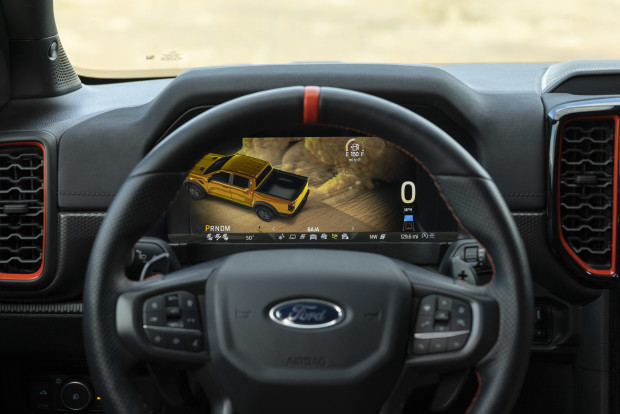
Courtesy Image
But the 2024 Ranger does leapfrog rivals with two other tech features: One is called Zone Lighting, that fires up all the exterior beacons on the truck, from the puddle lights under the mirrors to the bed, fog, and headlamps while the Ranger is parked, so you can set up a campsite. If you’re breaking camp before dawn, it’ll work great for that. It’ll illuminate a whole tailgate party for a Sunday night football matchup, too.
The other feature is called Pro Trailer Backup Assist, which integrates both a trailer brake controller and uses the Ranger’s cameras to aid in both connecting a trailer and also while reversing it. And you can add different trailer profiles to the trailering menu (say, your toy hauler vs. your boat) and set the lengths of those. Those presets then feed into the blind-spot system to virtually “lengthen” the truck and trailer footprint so you know when you might have another vehicle in your periphery.
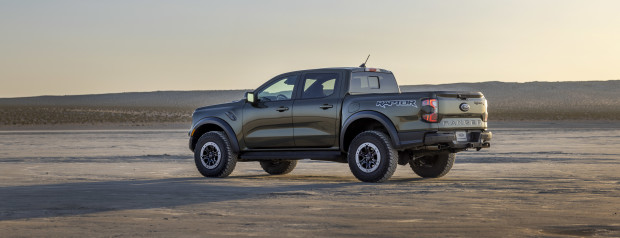
Courtesy Image
Better Bed Design
Often it’s the little things that make the biggest difference in a vehicle. Since this truck is all new (based on the Bronco and built in the same plant), Ford was able to widen the wheelbase and the track by about 2 inches. In turn, that enabled a wider bed that can now swallow four-foot-wide sheets of drywall or plywood with those loads falling flat between the wheel wells. Ford’s also added a step to the rear fender that’s integrated into the truck’s frame, so it can hold 300 pounds. If you’re a larger human, that’s going to be handy, and because that step is wide enough for two feet, you can stand outside the bed and hand gear out to another pair of hands in bucket-brigade fashion without losing your balance.
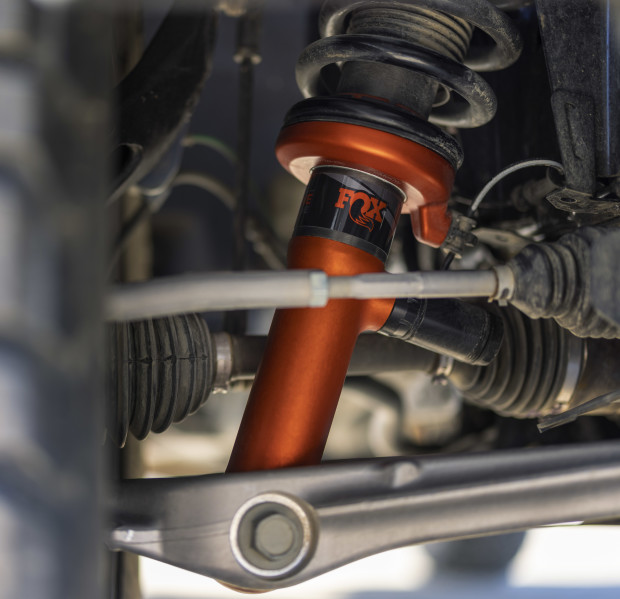
Off-road Chops and Better On-road Ride
The wider track allowed two key changes. First, Ford engineers could move the shocks outboard of the bed frame rails, which made it easier to dampen the busy-ness of the ride, especially for when you’re rolling in your Ranger without a payload. Again, we want to drive the new Ranger to confirm that, but essentially the argument is that a longer, wider truck can spread the load over a larger surface area.
The suspension is deeply revised for the Raptor. Not only is it lifted to 10.7 inches vs. 9.3 (approach and departure for Raptor is also better (29.2/25.8 for standard Ranger vs. 33/26.4 on Raptor), but the Raptor rides on a rear Watts link suspension with live valve Fox damping (similar to the F-150 Raptor). The fronts are coil-overs and the rear shocks have piggyback reservoirs.
The entire suspension is also a bit wider than the standard Ranger, and the Fox suspension has presets for different drive modes. There’s a pavement toggle (normal), settings for ice/snow, and of course rock crawling and baja modes that alter the suspension characteristics on the fly, plus modes for towing, etc.
Cost of 2024 Ford Ranger and Raptor
While we know the base price is $34,160 and Ranger Raptor will start at $56,960, the prices for the rungs in between weren’t released just yet. We do know that the base Ranger and Ranger Raptor go on sale first, later this summer, with the 2.7-liter models following in late fall.
from Men's Journal https://ift.tt/uNnD7zm


0 comments